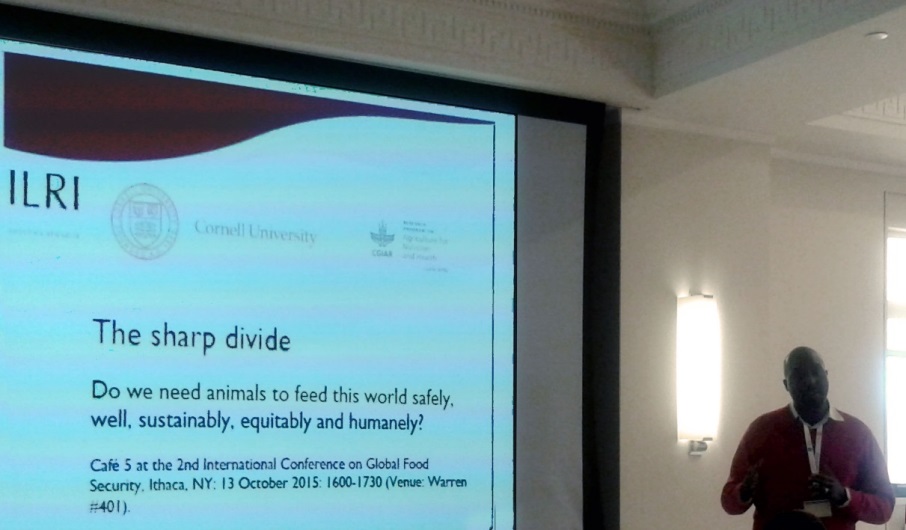Evidence shows that poor nutrition is an underlying cause of almost half of the global maternal and child mortality burden. These deaths have commonly been attributed to infectious diseases like diarrhea, malaria, HIV, and TB. Increasingly, a range of non-chronic illnesses like diabetes, heart disease, and cancer further complicates this burden. This realization has led us to understand that our health is also defined by what we eat. The linkage between agriculture, nutrition, and health is not really a new idea, though. Relatively new are the growing complexities involved in ensuring sustainable food systems and not just responding to the question on how we feed a growing population. Emerging challenges like climate change, land scarcity, and declining micronutrient content in the main high yielding staple varieties calls for integrated agriculture-nutrition-health efforts.
The recent 2nd International Conference Global Food Security brought together a range of researchers and practitioners working to address these questions. Of the eleven overarching themes discussed at this conference, the final one is the agriculture-nutrition-health “nexus.” We summarize some of the most interesting and new research presented under this theme here.
Marco Springmann of the Oxford’s Future of Food Program shared projections on the global and regional health impacts of future food production under climate change. Complex modeling of climate change estimate a negative impact on health for most countries, including possible 500,000 climate-related deaths by 2050. We now know that effects of climate change will go well-beyond agriculture, significantly affecting nutrition and health globally. Climate change mitigation, therefore, can substantially curtail these negative health impacts simultaneously.
During a group discussion led by Shirley Tarawali from the International Livestock Research Institute (ILRI) and Alice Pell from Cornell University, we asked, ”Do we need animals to feed this world safely, well, sustainably, equitably and humanely?” This linkage between nutrition and livestock production was divisive, and there were many charged (but polite) views on the topic. Colleagues brought perspectives from the global north and global south about nutritional needs based on context and even culture. People in wealthy nations might need to eat less animal-sourced foods, but the fact remains that the majority of the world still does not consume enough to meet their nutritional needs. Is it easier to ask a Kenyan or Texan to stop eating meat? Livestock in Africa is more than food; it serves various other purposes like traction, tilting land, manure, and biogas energy for cooking as well as electricity. In these settings, livestock means life. We concluded that there is no one-size-fits-all solution, but the burden of livestock production on the environment is not something that can be ignored, especially as we tackle both over-nutrition and under-nutrition challenges.

One of the most interesting sessions on the theme—titled “Nutrition-Sensitive Agriculture and Food Systems”—brought together experts including Ruth DeFries (Columbia University), Gero Carletto (World Bank), and Anna Herforth (Food and Nutrition Security Consultant). They reminded us of the need for novel ways of measuring dietary and nutrition quality and diversity as well as new understandings of the pathways from agriculture to nutrition. Furthermore, aspects of the “food environment” and its effects on diet are increasingly gaining attention. New measurements incorporating broad aspects such as food preferences need further exploration. Despite this viewpoint, it remains critical for the global technical community to understand how integrated agriculture-nutrition-health pathways emanate from the farm-level. Presenters also noted that the nutritional content of the “cereal basket” has significantly declined in the past five decades. It is not clear whether this decline is driven by the change in the mix of cereal types and/or the increasing focus on producing high yielding varieties. The novel “nutritional yield” indicator provides another way to measure diet diversity.
Common consensus across all thematic discussion also reminded us that context matters. Dr. R. Padmaja from ICRISAT shared experiences on gender in India, noting that “[How women spend their] time matters in agriculture, nutrition, and health. We therefore need to understand the context.” We must design and implement integrated interventions that are context-specific and consumer-based, working backwards from fork to farm.
Several great inter-disciplinary dialogues and efforts exist, including the Tata-Cornell Agriculture and Nutrition Initiative (TCi), the Cornell International Institute for Food, Agriculture and Development (CIIFAD), the World Bank’s SecureNutrition Platform, the TOPS Program’s Food Security and Nutrition Network (FSN Nutrition), the FAO’s Global Forum on Food Security and Nutrition, and the Agriculture-Nutrition Community of Practice (Ag2Nut CoP), among others. To ensure food systems provide for adequate nutrition and health, experts from agriculture, nutrition, and health sub-fields around the world need to follow these examples and work even more closely to advance efforts towards common goals.
Agriculture, nutrition, and health efforts implemented without addressing these known linkages are not achieving the impact we seek, especially for the most vulnerable. We need to better understand the pathways and design evidence-based interventions for addressing the complex underlying factors driving poverty, hunger, and malnutrition.


As an active designer and communicator, I can see the importance of working across fields to create solutions that really work. Nothing of value is developed in a vacuum. It takes a “village” of highly skilled people from all sorts of disciplines. It may have been a long time in coming, but I have high hopes that the work coming out of the conference and future projects that cross sectoral boundaries will actually bring the grand goals of feeding the world in a safe, healthy, and environmentally conscious way comes closer to reality. Kudos to Cecilia for the great article! Keep up the amazing work.